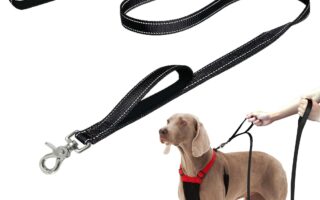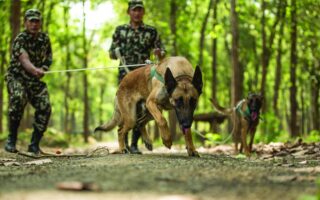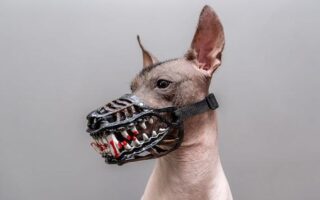Title: The Curious Case of Puppy Bites: Understanding the Joyful Nibbles of Our Canine Companions
As paws pad softly across the floor and tails wag with uncontainable excitement, few moments can rival the pure joy of puppyhood. Yet, amidst the playful antics and boundless energy, there lies a challenge that many new dog owners face—those not-so-gentle nibbles that can sometimes feel more like tiny shark attacks than affectionate bites. Understanding why puppies bite hard can illuminate the reasons behind their energetic behavior, offering insights that can help you forge a healthier, happier bond with your furry friend. In this article, we’ll explore the instinctual nature of puppy bites, the underlying motivations of this behavior, and effective strategies to guide your pup towards gentle play. Join us as we delve into the delightful, albeit sometimes painful, world of puppy teeth and learn how to navigate this crucial stage of development with grace and patience.
Table of Contents
- Understanding the Causes Behind Your Puppy’s Strong Bites
- Recognizing the Signs of Teething and Playful Aggression
- Effective Techniques for Redirecting Chewing Behavior
- Nurturing a Positive Bond Through Gentle Training Approaches
- Q&A
- To Wrap It Up
Understanding the Causes Behind Your Puppy’s Strong Bites
Puppies are naturally curious creatures, and their strong bites can sometimes be a surprising aspect of their playful nature. Understanding why your puppy may seem to bite harder than expected involves recognizing their developmental stage. During the teething phase, which usually occurs between three to six months of age, puppies often experience discomfort that leads them to chew and bite more vigorously. Additionally, their exploration of the world around them significantly involves their mouths; everything is a potential chew toy. Such behavior signifies a combination of playfulness, curiosity, and a need for relief from teething discomfort.
Another fundamental reason behind intense biting is simple enthusiasm during playtime. Their excitement often translates into stronger bites as they engage in social play with you or other pets. It’s essential to observe how they react during these moments. Consider the following factors that might contribute to hard biting:
- Under-stimulation: A lack of physical and mental exercise can lead to overexcitement during play.
- Learned Behavior: Puppies that have not been corrected may view biting as a part of the game.
- Attention Seeking: Strong bites can sometimes be a way for a puppy to get your attention.
Recognizing the Signs of Teething and Playful Aggression
Understanding your puppy’s behavior is crucial, especially when it comes to distinguishing between teething discomfort and playful aggression. Puppies go through a teething phase, typically between 3 to 6 months of age, when their baby teeth fall out and adult teeth come in. Signs that your puppy is teething may include:
- Increased chewing: A sudden interest in gnawing anything within reach.
- Excessive drooling: Moistness around the mouth, often accompanied by a bit of whining.
- Swollen gums: A closer inspection may reveal redness or swelling in their gums.
- Gnawing at toys: Preferring certain textures or items to soothe discomfort.
On the flip side, playful aggression can manifest as your energetic companion engages in activities with bites that seem to cross a line. Puppies often exhibit this behavior when they’re overexcited or trying to initiate play. Watch for the following indicators of playful aggression:
- Barking and growling: Playful sounds that indicate excitement rather than aggression.
- Pouncing or lunging: An energetic approach that’s more about fun than hostility.
- Tail wagging: A wagging tail is usually a sign of happiness rather than anger.
- Mouth open with soft bites: Gentle nibbles rather than hard chomps, as a way to engage.
Effective Techniques for Redirecting Chewing Behavior
Addressing excessive chewing behavior in puppies requires a combination of patience and clever strategies. One effective approach is the use of specialized chew toys that can divert their attention from inappropriate items. Consider selecting toys made from durable materials that can withstand vigorous gnawing. Additionally, introducing interactive toys that dispense treats can engage their minds and satisfy their instinctual need to chew. Providing a variety of textures and shapes will help maintain your puppy’s interest and encourage them to focus on appropriate chewing outlets.
Furthermore, positive reinforcement plays a crucial role in redirecting undesired chewing. Whenever your puppy chooses to chew on the designated toys instead of furniture or shoes, offer praise or a small treat to reinforce this behavior. Creating a simple reward chart can help track progress and motivate your puppy. Here’s a quick example:
| Chewing Behavior | Action Taken | Reward Given |
|---|---|---|
| Chewed on toy | Praise | Small Treat |
| Ignored furniture | Verbal Encouragement | Extra Playtime |
By combining enticing chew toys with positive reinforcement techniques, you’ll help your puppy understand what is acceptable to chew on while simultaneously nurturing their learning process.
Nurturing a Positive Bond Through Gentle Training Approaches
Training a puppy not to bite can be a challenging yet rewarding experience, especially when using gentle methods that foster trust and understanding. It’s important to recognize that puppies, like children, are learning about their environment through play and exploration. Instead of resorting to harsh reprimands, consider employing these nurturing techniques to promote better behavior:
- Redirection: Offer a variety of chew toys to occupy their mouths and energies, guiding them away from your hands.
- Positive Reinforcement: Reward calm behavior with treats and praise, helping them associate gentle play with positive outcomes.
- Socialization: Gradually introduce them to other well-mannered dogs or people, teaching them appropriate interaction through observation.
Creating a set of guidelines can help maintain consistency as your puppy learns. This can be structured in a simple table format for quick reference during training sessions:
| Action | Response |
|---|---|
| Play bite occurs | “Ow!” – A light yelp to signal they’re biting too hard. |
| Puppy redirects to toys | Offer treats and praise to encourage this behavior. |
| Puppy calms down | Engage in gentle petting and vocal praise. |
By embracing these gentle approaches, you not only reduce the chances of destructive biting but also strengthen the bond between you and your furry companion. The key lies in patience, consistency, and maintaining a nurturing environment that emphasizes learning through love and understanding.
Q&A
Q&A: Understanding “Puppy Bites Hard”
Q: Why do puppies bite hard?
A: Puppies explore their world through their mouths, much like babies. Their natural instinct involves chewing, nibbling, and biting as part of their play and teething process. Sometimes, those tiny teeth can feel sharper than intended!
Q: Is it normal for puppies to bite hard during play?
A: Yes, it’s quite normal! Play biting is common among puppies as they interact with their littermates and humans. However, if their bites are consistently hard, it’s important to teach boundaries to ensure safe play.
Q: How can I tell if my puppy’s bite is play or aggression?
A: Play biting typically involves a lot of wiggly body language, such as wagging tails and playful barks. If your puppy growls, shows teeth without playful intent, or postures rigidly, it may be a sign of aggression rather than play.
Q: What should I do if my puppy bites too hard?
A: If your puppy bites hard, make a loud yelp or say “ouch!” to mimic the sound their littermates would make. This can help them learn that their bite is too strong. Then, redirect their energy to a toy or engage them in a different activity.
Q: Can puppy biting lead to bad behavior in adulthood?
A: If not managed, strong biting habits may persist into adulthood, leading to undesirable behaviors. Teaching bite inhibition early can help prevent this. Consistent training and socialization are key to ensuring your puppy develops healthy habits.
Q: Are some breeds more prone to hard biting than others?
A: While all puppies can bite hard, certain breeds with strong jaws or high energy levels may seem more prone to it. However, each puppy is unique, and proper training can help any breed learn appropriate play behavior.
Q: When should I seek professional help for my puppy’s biting?
A: If biting becomes aggressive, frequent, or accompanied by fear-based behaviors, it may be beneficial to consult a professional dog trainer or behaviorist. They can assess the situation and provide strategies tailored to your puppy’s needs.
Q: How can I provide my puppy with appropriate outlets for their biting?
A: Providing a variety of toys, such as chew toys, rubber bones, or tug ropes, can channel your puppy’s biting behavior in a productive way. Engaging them in regular play sessions also helps release pent-up energy that might lead to excessive biting.
Q: What are the long-term impacts of unaddressed hard biting?
A: Unaddressed hard biting can lead not only to injuries but also may foster a lack of trust between the puppy and their humans. It’s essential to establish a positive learning environment where the puppy feels safe understanding acceptable behaviors.
By understanding why puppies bite hard and how to manage this behavior, you can foster a positive relationship with your furry friend that lasts a lifetime!
To Wrap It Up
As we wrap up our exploration of the intriguing phenomenon of “puppy bites hard,” it’s clear that this behavior is a natural part of a puppy’s development. Understanding the reasons behind those enthusiastic nibbles and playful nips can help us respond with patience and strategy. From the excitement of play to the teething process, recognizing these motivations allows us to foster a healthier human-animal bond while guiding our furry companions toward more appropriate behaviors. Ultimately, navigating the world of puppy bites is not just about managing the moment but about embracing the journey of growth, training, and mutual understanding. As you continue your adventure with your spirited pup, remember that every bite is a step toward the rich tapestry of companionship that lies ahead. Happy training!


